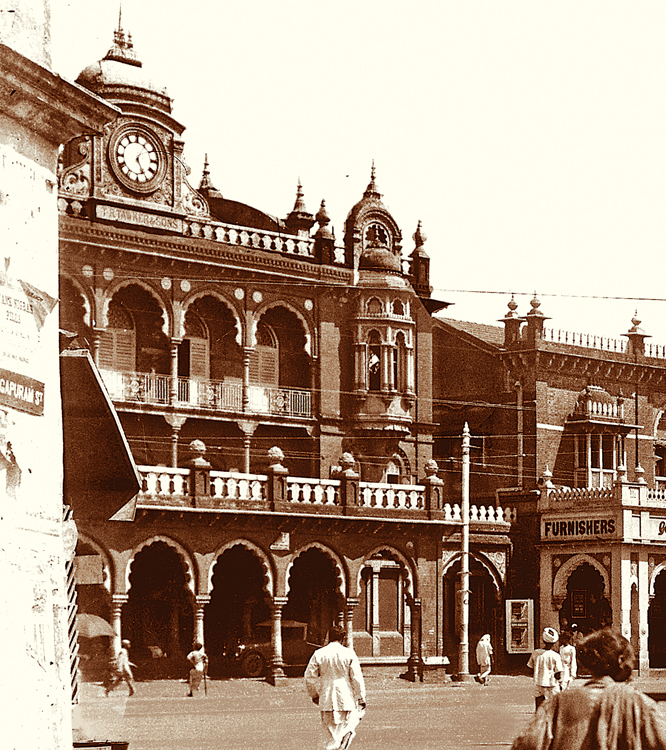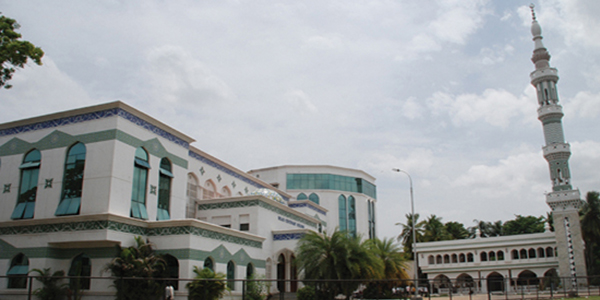Registered with the Registrar of Newspapers for India under R.N.I 53640/91
Vol. XXVIII No. 2, May 1-15, 2018
Lost Landmarks of Chennai
- SRIRAM V
The Tawkers of Gujarat remembered

A portion of Tawker’s showroom on Mount Road – a landmark now only a memory. (Courtesy: Vintage Vignettes.)
In their time, which was mid-19th to early 20th Century, the Tawkers were among the foremost Gujarati families of Madras. They were also among the earliest migrants from the west coast of India to settle in the south. Their fortunes were made in gems and jewellery, and they were the suppliers of choice to several royal families of India, wealthy business magnates and courtesans. To be able to purchase from the Tawkers you had to be of some status.
The Tawkers suffixed their given names with the initial T and this stood for Tiruchirappalli, which is where they had lived for centuries. Even today, Tawker Chattiram Street near the Rock Fort area commemorates the family. In Madras, Ayanavaram has a Tawker Chattiram (resthouse) and a Kasi Viswanatha Swami temple adjoining it, both of which were built in the 18th Century by two women of the clan – Ramkor Bai and Ratna Bai. The earliest Tawker mentioned in the records is Nilakanta and dates to 1759. He features in a diary entry of Ananda Ranga Pillai. The descendants did business under the name of T.R. Tawker & Sons.

New College, where Tawkers’ Gardens once was.
By the mid-1890s, the firm had shifted its headquarters to Madras, where Henry Irwin, Consulting Architect to the Government of Madras, built a beautiful showroom on Mount Road. The family residence was on a huge parcel of land on Peter’s Road and was named Tawkers’ Gardens. In its time it must have been a well-known landmark, in keeping with the exalted status of the family. Who’s Who-s of the time give details of T. Ranganatha Kripashankar Tawker and mention this to be his residential address.
But trouble was already brewing. In 1910 or so, the Tawkers were ordered to make a diamond-studded robe for that jewel-loving and fabulously rich potentate – His Highness Asaf Jah VI Mir Mahbub Ali Khan, the Nizam of Hyderabad. Business with royalty was done on trust. No papers were signed and the ruler’s word was as good as his bond. The Tawkers delivered the robe sometime in 1911. The Nizam unfortunately died in August that year and nothing was ever heard from his treasury of either the robe or the payment for it. That at least is the legend. In actual fact it would appear that the Tawkers’ troubles began in 1916 when they mortgaged the title deeds of all their properties in Madras, Bangalore and Trichy, and the village of Pallikarney (!!!), to the firm of Nagarseth & Sons, Bombay, for a sum of Rs 18.00 lakh. From this it would appear that the Great War too was in some way responsible for their difficulties.
In 1922, the Nagarseths filed a suit against the Tawkers in the High Court of Bombay for the enforcement of the mortgage. Thereafter, matters went downhill for the Tawkers, leading to their declaring insolvency on January 17, 1925, even while the case in Bombay was in progress. Tawker’s Gardens, along with the rest of the family’s possessions, became the responsibility of the Official Assignee of the Government. With the Tawkers moving out, the house became the residence of the Chief Minister of Madras – P Ramarayaningar, aka the Rajah of Panagal. He lived there till his passing in 1928.
There were several cases involving the Tawker family in Madras and Trichy and in the midst of it all, the Thakur Sahib of Limbdi, a small princely state in Gujarat, interested himself in the proceedings on the strength of his having loaned money to the Nagarseths for their loan to the Tawkers. The title deeds of Tawkers’ Gardens were in fact in his possession. Eventually, the property became his and he changed its name to Limbdi Gardens. The travails of the Tawkers however ended only in 1938 when all the suits filed against them were settled by a judgement of Sir C. Madhavan Nair. By then, the case also involved such wellknown business barons as P.M.A. Muthiah Chettiar and S.Rm.M.Rm. Ramanathan Chettiar.
By the early 1930s, we find the University of Madras was renting Limbdi Gardens. The Departments of History and Zoology were occupants, and by 1932, when it was founded, the School of Fine and Performing Arts, also known as the Department of Indian Music, began functioning from here. The Oriental Research Institute too was in the same premises. Limbdi Gardens in its time must have echoed therefore to the voices of such greats as ‘Tiger’ Varada chariar, first head of the Music Department, K.A. Nilakanta Sastry of the History Department, Sir. K. Ramunni Menon, who, despite being Vice-chancellor, found time to take classes in Zoology, and S. Vaiyapuri Pillai of the Tamil Department, the editor of the hitherto unsurpassed Tamil Lexicon. Queen Mary’s College too appears to have used some parts of Limbdi Gardens in the 1930s.
The University seems to have moved its Departments out by the early 1940s and the next we hear of the place is when, for reasons unknown, the property came up for auction in 1945. It was purchased by Mohammed Sulaiman, the founder of Presidency Transport Limited, a company that ran bus services within Madras and also from here to several towns in the districts.
Shortly after Indepedence, the Muslim Educational Association for Southern India (MEASI) expressed interest in the property. The Government had changed the name of the Mohammedan College, functioning from Umda Bagh on Mount Road, to Government Arts College and also limited the admission quota for Muslim students. MEASI felt it was time the Muslims had a college of their own. In his biography, Justice Basheer Ahmed Sayeed states that Limbdi Gardens, which comprised a huge two-storey building set amidst 12 acres of land, was acquired for a sum of Rs 4,36,000 in 1948. This is also, significantly, the only description of the old Tawker residence that had stood at the southern end of the property.
New College, its name inspired by the historic institution at Oxford, began functioning at Limbdi Gardens from July 2, 1951. Over a period, the College demolished all of the Tawkers’ residence for building premises suited to its functioning. It is said that there is a photograph still surviving of the old edifice, but it is not in the public domain. Today’s generation can only marvel at the possibility of a family residence set amidst 12 acres of land in a prime part of the city.

